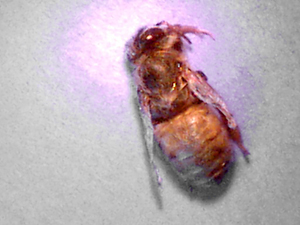It's always something, eh? The current anxiety is "PMS," or "Parasitic Mite Syndrome," a disease caused by Varroa mites. The mites get into the cell where the honeybee is developing, pierce the larvae to suck its blood, and introduce viruses that cause deformation of wings and abdomens. I saw PMS bees when I fed the other day, and began to wonder whether there was a big problem brewing.
 This (dead) honeybee has the classic signs of PMS, little shrivelled wing slivers that are very different from the tattered wings you might find on old bees. This honeybee never had a chance: without wings, she could never fly or forage, and she was probably cast out by her sisters as a result. Yesterday, I found a PMS bee very far from the hives, too far for her to creep. One of her sisters had picked her up, flown her off, and dropped her — hygienic behavior that is good for the hive but bad for the sentimental heart.
This (dead) honeybee has the classic signs of PMS, little shrivelled wing slivers that are very different from the tattered wings you might find on old bees. This honeybee never had a chance: without wings, she could never fly or forage, and she was probably cast out by her sisters as a result. Yesterday, I found a PMS bee very far from the hives, too far for her to creep. One of her sisters had picked her up, flown her off, and dropped her — hygienic behavior that is good for the hive but bad for the sentimental heart. Just to belabor the point a bit, here is a picture of a wing taken at 60x magnification by my husband. Those two frozen stubs are wings that never were. The name of the order to which bees belong, Hymenoptera, refers to their two pairs of twinned, gauzy wings. This just seems like a particularly mean spirited flavor of destruction to me.
Just to belabor the point a bit, here is a picture of a wing taken at 60x magnification by my husband. Those two frozen stubs are wings that never were. The name of the order to which bees belong, Hymenoptera, refers to their two pairs of twinned, gauzy wings. This just seems like a particularly mean spirited flavor of destruction to me.The most important thing to know now is whether I have a problem (if I do, how to handle it is a completely different mystery, since I thought I took action already). In any case, I asked for advice both from the BeeSource.com bulletin boards and my local beekeeper club. Both groups said the same thing: get a mite count. These could be old bees left over from before you treated for varroa in the Fall, they could be newer bees emerging after an ineffective treatment: with beekeepers if you ask two folks you get 6 opinions (this is not a joke). The old bee scenario means "no problem," the new bee scenario means "condition red." If I have a high mite count, it means the latter.
So I have embarked on counting mites, you can see how I have started by looking at the "Making a Sticky Board" page in the links at the right. Your advice is very welcome, and any comments will be read right away.
No comments:
Post a Comment